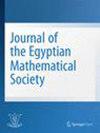The periodic rotary motions of a rigid body in a new domain of angular velocity
引用次数: 1
Abstract
In the previous works, the limiting case for the motion of a rigid body about a fixed point in a Newtonian force field, which comes from a gravity center lies on Z -axis, is solved. The authors apply the small parameter technique which is achieved giving the body a sufficiently large angular velocity component r o about the fixed z -axis of the body. The periodic solutions of motion are obtained in neighborhood r o tends to $$\infty$$ ∞ . In our work, we aim to find periodic solutions to the problem of motion in the neighborhood of r 0 tends to $$0$$ 0 . So, we give a new assumption that: r o is sufficiently small. Under this assumption, we must achieve a large parameter and search for another technique for solving this problem. This technique is named; a large parameter technique instead of the small one well known previously. We see the advantage of the new technique which appears in saving high energy used to begin the motion and give the solution of the problem in another domain. The obtained solutions by the new technique depend on r o . We consider that the center of mass of this body does not necessarily coincide with the fixed point O. We reduce the six nonlinear differential equations of the body and their three first integrals to a quasilinear autonomous system of two degrees of freedom and one first integral. We solve the rational case when the frequencies of the generating system are rational except $$(\,\omega = \,1,\,2,1/2,3,1/3, \ldots )$$ ( ω = 1 , 2 , 1 / 2 , 3 , 1 / 3 , … ) under the condition $$\gamma^{\prime\prime}_{0} = \cos \theta_{o} \approx 0$$ γ 0 ″ = cos θ o ≈ 0 . We use the fourth-order Runge–Kutta method to find the periodic solutions in the closed interval of the time t and to compare the analytical method with the numerical one.在新的角速度域中刚体的周期旋转运动
在以前的工作中,解决了一个刚体在牛顿力场中,由重力中心在Z轴上的固定点运动的极限情况。作者采用小参数技术,使物体在固定z轴上有足够大的角速度分量。在邻域r o趋于$$\infty$$∞时,得到了运动的周期解。在我们的工作中,我们的目标是找到在r 0附近趋向于$$0$$ 0的运动问题的周期解。所以,我们给出一个新的假设,r o足够小。在这种假设下,我们必须实现一个大的参数,并寻找另一种技术来解决这个问题。这种技术被命名为;一种大参数技术,而不是以前众所周知的小参数技术。我们看到了新技术的优点,即节省了启动运动所需的大量能量,并在另一个域中给出了问题的解。新方法得到的解依赖于r。我们认为该物体的质心不一定与不动点o重合。我们将该物体的六个非线性微分方程及其三个前积分化为一个二自由度和一个前积分的拟线性自治系统。在$$\gamma^{\prime\prime}_{0} = \cos \theta_{o} \approx 0$$ γ 0″= cos θ o≈0的条件下,求解了除$$(\,\omega = \,1,\,2,1/2,3,1/3, \ldots )$$ (ω = 1,2,1 / 2,3,1 / 3,…)以外的所有发电系统频率的有理数情况。利用四阶龙格-库塔法求出时间t闭区间内的周期解,并将解析法与数值法进行比较。
本文章由计算机程序翻译,如有差异,请以英文原文为准。
求助全文
约1分钟内获得全文
求助全文

 求助内容:
求助内容: 应助结果提醒方式:
应助结果提醒方式:


